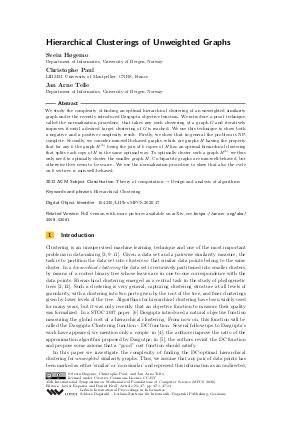Hierarchical Clusterings of Unweighted Graphs
Authors Svein Høgemo, Christophe Paul, Jan Arne Telle
-
Part of:
Volume:
45th International Symposium on Mathematical Foundations of Computer Science (MFCS 2020)
Part of: Series: Leibniz International Proceedings in Informatics (LIPIcs)
Part of: Conference: Mathematical Foundations of Computer Science (MFCS) - License:
 Creative Commons Attribution 3.0 Unported license
Creative Commons Attribution 3.0 Unported license
- Publication Date: 2020-08-18
File

PDF
LIPIcs.MFCS.2020.47.pdf
- Filesize: 0.49 MB
- 13 pages
Document Identifiers
Related Versions
-
Full version with more pictures available on arXiv, see https://arxiv.org/abs/2008.03061.
Subject Classification
ACM Subject Classification
- Theory of computation → Design and analysis of algorithms
Keywords
- Hierarchical Clustering
Metrics
- Access Statistics
-
Total Accesses (updated on a weekly basis)
0PDF Downloads0Metadata Views
Abstract
We study the complexity of finding an optimal hierarchical clustering of an unweighted similarity graph under the recently introduced Dasgupta objective function. We introduce a proof technique, called the normalization procedure, that takes any such clustering of a graph G and iteratively improves it until a desired target clustering of G is reached. We use this technique to show both a negative and a positive complexity result. Firstly, we show that in general the problem is NP-complete. Secondly, we consider min-well-behaved graphs, which are graphs H having the property that for any k the graph H^{(k)} being the join of k copies of H has an optimal hierarchical clustering that splits each copy of H in the same optimal way. To optimally cluster such a graph H^{(k)} we thus only need to optimally cluster the smaller graph H. Co-bipartite graphs are min-well-behaved, but otherwise they seem to be scarce. We use the normalization procedure to show that also the cycle on 6 vertices is min-well-behaved.
Cite As Get BibTex
Svein Høgemo, Christophe Paul, and Jan Arne Telle. Hierarchical Clusterings of Unweighted Graphs. In 45th International Symposium on Mathematical Foundations of Computer Science (MFCS 2020). Leibniz International Proceedings in Informatics (LIPIcs), Volume 170, pp. 47:1-47:13, Schloss Dagstuhl – Leibniz-Zentrum für Informatik (2020)
https://doi.org/10.4230/LIPIcs.MFCS.2020.47
BibTex
@InProceedings{hgemo_et_al:LIPIcs.MFCS.2020.47,
author = {H{\o}gemo, Svein and Paul, Christophe and Telle, Jan Arne},
title = {{Hierarchical Clusterings of Unweighted Graphs}},
booktitle = {45th International Symposium on Mathematical Foundations of Computer Science (MFCS 2020)},
pages = {47:1--47:13},
series = {Leibniz International Proceedings in Informatics (LIPIcs)},
ISBN = {978-3-95977-159-7},
ISSN = {1868-8969},
year = {2020},
volume = {170},
editor = {Esparza, Javier and Kr\'{a}l', Daniel},
publisher = {Schloss Dagstuhl -- Leibniz-Zentrum f{\"u}r Informatik},
address = {Dagstuhl, Germany},
URL = {https://drops.dagstuhl.de/entities/document/10.4230/LIPIcs.MFCS.2020.47},
URN = {urn:nbn:de:0030-drops-127139},
doi = {10.4230/LIPIcs.MFCS.2020.47},
annote = {Keywords: Hierarchical Clustering}
}
Author Details
References
-
N. Bansal, A. Blum, and S. Chawla. Correlation clustering. Machine Learning, 56(1-3):89-113, 2004.

-
P. Buneman. The recovery of trees from measures of dissimilarity. Mathematics in the Archaeological and Historical Sciences, pages 387-395, 1971.

-
S. Chakrabarti, M. Ester, U. Fayyad, J. Gehrke, J. Han, S. Morishita, G. Piatetsky-Shapiro, and W. Wang. Data mining curriculum: A proposal (version 1.0). Technical report, Intensive Working Group of ACM SIGKDD, 2006.

-
M. Charikar and V. Chatziafratis. Approximate hierarchical clustering via sparsest cut and spreading metrics. In Annual ACM-SIAM symposium on Discrete algorithms (SODA), pages 841-854, 2017.

-
V. Cohen-Addad, V. Kanade, F. Mallmann-Trenn, and C. Mathieu. Hierarchical clustering: Objective functions and algorithms. Journal of ACM, 66(4):26:1-26-42, 2019.

-
S. Dasgupta. A cost function for similarity-based hierarchical clustering. In Annual ACM symposium on Theory of Computing (STOC), pages 118-127, 2016.

-
S. Dasgupta. Hardness of hierarchical clustering optimization. Private communication, 2019.

-
R. Diestel. Graph theory. Springer-Verlag, 2005.

-
J. Hartigan. Clustering algorithms. John Wiley and Sons, 1975.

-
T. Hastie, R. Tibshirani, and J. Friedman. The elements of statistical learning: data mining, inference, and prediction. Springer Series in Statistics. Springer, second edition, 2009.

-
K. Koutroumbas and S. Theodoridis. Pattern recognition. Academic Press, fourth edition, 2009.

-
R. Sokal and P. Sneath. Numerical taxonomy. W.H. Freeman, 1963.

